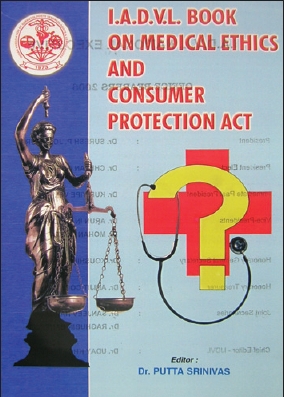Translate this page into:
IADVL book on medical ethics and consumer protection act
Correspondence Address:
Gurmohan Singh
India
| How to cite this article: Singh G. IADVL book on medical ethics and consumer protection act. Indian J Dermatol Venereol Leprol 2007;73:213 |
 |
| Figure 1 |
 |
| Figure 1 |
Editor: Putta Srinivas
Publisher : Indian Association of Dermatology, Venereology and Leprology (IADVL), 1 st edition
Pages: 151
The IADVL book on medical ethics and consumer protection act is a welcome publication of the IADVL that is compiled and edited by Dr. Putta Srinivas. It is meant for free distribution amongst members of IADVL. It is a well laid out monograph contributed by many authors, with a major share from the editor himself.
It comprises 15 chapters. The last nine are a reproduction of various codes of ethics and acts pertaining to medical practice, which is essential for all of us to know. It is very convenient for readers to have all the material compiled in a book form. These chapters are not for reference but to read, grasp and implement in daily practice.
The first three chapters are contributed by the editor himself, through exhaustive research of the cases and judgments of interest to dermatologists. These also include an overview of medical negligence and various acts related to it and preventive steps to avoid litigation. Chapter 3 illustrates the opinion of the judiciary about the medical profession through various past judgments.
In Chapter 1 Dr. Srinivas has given many "Dos" for dermatologists to practice. The 12 th "DO" is that dermatologists must keep a copy of the prescription given to OPD patient which for most dermatology outpatients is difficult to practice. On page 3, the author has written that we should ask the patient to verify the prescribed medicines with the concerned doctor before use. This type of strict supervision by the doctors is probably unnecessary. On the other hand, if the patient voluntarily brings the medication for verification, this must be done either by the consultant himself or an assistant along with reiteration of the method of use.
There is another ambiguity in the first chapter. The author advises consent by the patient in dermatological emergencies (page 5), although this is not mandatory in cases of medical emergencies. It should be sufficient to counsel the patient/caretakers and this should be recorded on the file. As the book is endorsed by IADVL, these points may make dermatologists more vulnerable in future cases.
The fourth chapter on "Ethical Issues on Clinical Trials" has been well written by Dr. S. Sacchidanand. The chapter on "Ethical Issues in Cosmetology" by Dr. Arijit Coondoo sends a very important message to younger dermatologists, particularly those who are employed by "Cosmetology Clinics", that they should practice methods of healing founded on a scientific basis and should not associate professionally with anyone who violates these principles.
Overall this book is extremely useful not only for younger dermatologists but also for all of us. It will help prevent litigation for anyone who cares to read this book and follow the advice. Further, in case of litigation, it advises us not to become nervous and informs us of the procedures to be adopted. Every IADVL member must read it thoroughly and practice its contents.
Fulltext Views
1,985
PDF downloads
1,855





